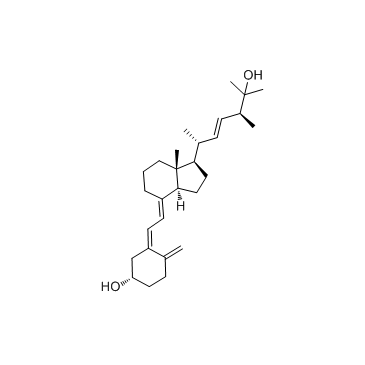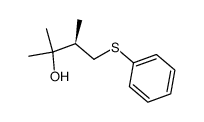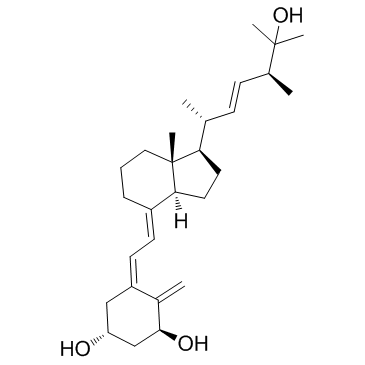21343-40-8
| 中文名 | 25-羟基维生素 D2 |
|---|---|
| 英文名 | 25-hydroxyvitamin D2 |
| 中文别名 |
25-羟麦角甾醇
25-羟基维他命D2(25-羟麦角甾醇) 25-羟基维生素D2 25-羟基维生素d2 25-羟基维生素 |
| 英文别名 |
25-Hydroxy Vitamin D2
(3S,5Z,7E,20R,22E)-9,10-Secoergosta-5,7,10,22-tetraene-3,25-diol 9,10-Secoergosta-5,7,10(19),22-tetraene-3b,25-diol 9,10-Secoergosta-5,7,10(19),22-tetraene-3β,25-diol Ercalcidiol,3β,5Z,7E,22E)-9,10-secoergosta-5,7,10(19),22-tetraen-3,25-diol EINECS 200-578-6 25-Hydroxyvitamin D2 25-Hydroxyvitamin D 2 25-Hydroxyergocalciferol 25-Hydroxyergocalciferol 25-Hydroxycalciferol MFCD02683431 25-Hydroxycalciferol Ercalcidiol |
| 描述 | Ercalcidiol 是一种 vitamin D2 代谢物,作为 vitamin D 营养状态的指标。 |
|---|---|
| 相关类别 | |
| 靶点 |
Human Endogenous Metabolite |
| 体外研究 | Ercalcidiol(25(OH)D2)和25(OH)D3之间的区别对于监测维生素D治疗非常重要,因为维生素D2是主要的处方形式。 Ercalcidiol的半衰期短于25(OH)D3的半衰期,并且它与维生素D结合蛋白的结合较差,使其效力较低,因此需要以比维生素D3高得多的剂量给药。一些目前使用的检测方法检测Ercalcidiol的能力降低,当试图用维生素D2监测治疗时,这会导致危险的过量给药[2]。 |
| 参考文献 |
| 密度 | 1.0±0.1 g/cm3 |
|---|---|
| 沸点 | 542.3±38.0 °C at 760 mmHg |
| 熔点 | 45-51ºC |
| 分子式 | C28H44O2 |
| 分子量 | 412.648 |
| 闪点 | 225.9±21.4 °C |
| 精确质量 | 412.334137 |
| PSA | 40.46000 |
| LogP | 7.56 |
| 蒸汽压 | 0.0±3.3 mmHg at 25°C |
| 折射率 | 1.543 |
| 储存条件 | −20°C |
|
SECTION 1: Identification of the substance/mixture and of the company/undertaking Product identifiers Product name: 25-Hydroxyvitamin D2 REACH No.: A registration number is not available for this substance as the substance or its uses are exempted from registration, the annual tonnage does not require a registration or the registration is envisaged for a later registration deadline.
CAS-No.: 21343-40-8 Relevant identified uses of the substance or mixture and uses advised against Identified uses: Laboratory chemicals, Manufacture of substances SECTION 2: Hazards identification Classification of the substance or mixture Classification according to Regulation (EC) No 1272/2008 Acute toxicity, Oral (Category 2), H300 Acute toxicity, Inhalation (Category 1), H330 Acute toxicity, Dermal (Category 2), H310 Specific target organ toxicity - repeated exposure, Oral (Category 1), H372 For the full text of the H-Statements mentioned in this Section, see Section 16. Classification according to EU Directives 67/548/EEC or 1999/45/EC T+ Very toxicR24/25, R26, R48/25 For the full text of the R-phrases mentioned in this Section, see Section 16. Label elements Labelling according Regulation (EC) No 1272/2008 Pictogram Signal wordDanger Hazard statement(s) H300 + H310 + H330Fatal if swallowed, in contact with skin or if inhaled H372Causes damage to organs through prolonged or repeated exposure if swallowed. Precautionary statement(s) P260Do not breathe dust/ fume/ gas/ mist/ vapours/ spray. P264Wash hands thoroughly after handling. P280Wear protective gloves/ protective clothing. P284Wear respiratory protection. P301 + P310IF SWALLOWED: Immediately call a POISON CENTER or doctor/ physician. P302 + P350IF ON SKIN: Gently wash with plenty of soap and water. Supplemental Hazardnone Statements Other hazards - none SECTION 3: Composition/information on ingredients Substances Synonyms: 25-Hydroxycalciferol 25-Hydroxyergocalciferol Formula: C28H44O2 Molecular Weight: 412,65 g/mol CAS-No.: 21343-40-8 Hazardous ingredients according to Regulation (EC) No 1272/2008 ComponentClassificationConcentration 25-Hydroxyvitamin D2 CAS-No.21343-40-8Acute Tox. 2; Acute Tox. 1;<= 100 % Acute Tox. 2; STOT RE 1; H300 + H310 + H330, H372 Hazardous ingredients according to Directive 1999/45/EC ComponentClassificationConcentration 25-Hydroxyvitamin D2 CAS-No.21343-40-8T+, R24/25 - R26 - R48/25<= 100 % For the full text of the H-Statements and R-Phrases mentioned in this Section, see Section 16 SECTION 4: First aid measures Description of first aid measures General advice Consult a physician. Show this safety data sheet to the doctor in attendance. If inhaled If breathed in, move person into fresh air. If not breathing, give artificial respiration. Consult a physician. In case of skin contact Wash off with soap and plenty of water. Take victim immediately to hospital. Consult a physician. In case of eye contact Flush eyes with water as a precaution. If swallowed Never give anything by mouth to an unconscious person. Rinse mouth with water. Consult a physician. Most important symptoms and effects, both acute and delayed The most important known symptoms and effects are described in the labelling (see section 2.2) and/or in section 11 Indication of any immediate medical attention and special treatment needed no data available SECTION 5: Firefighting measures Extinguishing media Suitable extinguishing media Use water spray, alcohol-resistant foam, dry chemical or carbon dioxide. Special hazards arising from the substance or mixture Carbon oxides Advice for firefighters Wear self contained breathing apparatus for fire fighting if necessary. Further information no data available SECTION 6: Accidental release measures Personal precautions, protective equipment and emergency procedures Wear respiratory protection. Avoid dust formation. Avoid breathing vapours, mist or gas. Ensure adequate ventilation. Evacuate personnel to safe areas. Avoid breathing dust. For personal protection see section 8. Environmental precautions Prevent further leakage or spillage if safe to do so. Do not let product enter drains. Methods and materials for containment and cleaning up Pick up and arrange disposal without creating dust. Sweep up and shovel. Keep in suitable, closed containers for disposal. Reference to other sections For disposal see section 13. SECTION 7: Handling and storage Precautions for safe handling Avoid contact with skin and eyes. Avoid formation of dust and aerosols. Provide appropriate exhaust ventilation at places where dust is formed. For precautions see section 2.2. Conditions for safe storage, including any incompatibilities Store in cool place. Keep container tightly closed in a dry and well-ventilated place. Recommended storage temperature: -70 °C Specific end use(s) Apart from the uses mentioned in section 1.2 no other specific uses are stipulated SECTION 8: Exposure controls/personal protection Control parameters Components with workplace control parameters Exposure controls Appropriate engineering controls Avoid contact with skin, eyes and clothing. Wash hands before breaks and immediately after handling the product. Personal protective equipment Eye/face protection Face shield and safety glasses Use equipment for eye protection tested and approved under appropriate government standards such as NIOSH (US) or EN 166(EU). Skin protection Handle with gloves. Gloves must be inspected prior to use. Use proper glove removal technique (without touching glove's outer surface) to avoid skin contact with this product. Dispose of contaminated gloves after use in accordance with applicable laws and good laboratory practices. Wash and dry hands. The selected protective gloves have to satisfy the specifications of EU Directive 89/686/EEC and the standard EN 374 derived from it. Full contact Material: Nitrile rubber Minimum layer thickness: 0,11 mm Break through time: 480 min Material tested:Dermatril® (KCL 740 / Z677272, Size M) Splash contact Material: Nitrile rubber Minimum layer thickness: 0,11 mm Break through time: 480 min Material tested:Dermatril® (KCL 740 / Z677272, Size M) data source: KCL GmbH, D-36124 Eichenzell, phone +49 (0)6659 87300, test method: EN374 If used in solution, or mixed with other substances, and under conditions which differ from EN 374, contact the supplier of the CE approved gloves. This recommendation is advisory only and must be evaluated by an industrial hygienist and safety officer familiar with the specific situation of anticipated use by our customers. It should not be construed as offering an approval for any specific use scenario. Body Protection Complete suit protecting against chemicals, The type of protective equipment must be selected according to the concentration and amount of the dangerous substance at the specific workplace. Respiratory protection Where risk assessment shows air-purifying respirators are appropriate use a full-face particle respirator type N100 (US) or type P3 (EN 143) respirator cartridges as a backup to engineering controls. If the respirator is the sole means of protection, use a full-face supplied air respirator. Use respirators and components tested and approved under appropriate government standards such as NIOSH (US) or CEN (EU). Control of environmental exposure Prevent further leakage or spillage if safe to do so. Do not let product enter drains. SECTION 9: Physical and chemical properties Information on basic physical and chemical properties a) AppearanceForm: crystalline Colour: white b) Odourno data available c) Odour Thresholdno data available d) pHno data available e) Melting point/freezing88,0 - 95,0 °C point f) Initial boiling point and no data available boiling range g) Flash pointno data available h) Evapouration rateno data available i) Flammability (solid, gas) no data available j) Upper/lowerno data available flammability or explosive limits k) Vapour pressureno data available l) Vapour densityno data available m) Relative densityno data available n) Water solubilityinsoluble o) Partition coefficient: n- no data available octanol/water p) Auto-ignitionno data available temperature q) Decompositionno data available temperature r) Viscosityno data available s) Explosive propertiesno data available t) Oxidizing propertiesno data available Other safety information no data available SECTION 10: Stability and reactivity Reactivity no data available Chemical stability Stable under recommended storage conditions. Possibility of hazardous reactions no data available Conditions to avoid no data available Incompatible materials Strong oxidizing agents, Strong acids, Strong bases Hazardous decomposition products Other decomposition products - no data available In the event of fire: see section 5 SECTION 11: Toxicological information Information on toxicological effects Acute toxicity no data available LC50 Inhalation - rat - 4 h - 130 - 380 ppm LD50 Dermal - rat - 61 mg/kg Skin corrosion/irritation no data available Serious eye damage/eye irritation no data available Respiratory or skin sensitisation Prolonged or repeated exposure may cause allergic reactions in certain sensitive individuals. Germ cell mutagenicity no data available Carcinogenicity IARC:No component of this product present at levels greater than or equal to 0.1% is identified as probable, possible or confirmed human carcinogen by IARC. Reproductive toxicity Overexposure may cause reproductive disorder(s) based on tests with laboratory animals. Specific target organ toxicity - single exposure no data available Specific target organ toxicity - repeated exposure no data available Ingestion - Causes damage to organs through prolonged or repeated exposure. Aspiration hazard no data available Additional Information RTECS: Not available Effects due to ingestion may include:, Nausea, Headache, Vomiting, Diarrhoea, Weakness, Rash, Itching Heart - SECTION 12: Ecological information Toxicity no data available Persistence and degradability no data available Bioaccumulative potential no data available Mobility in soil no data available Results of PBT and vPvB assessment PBT/vPvB assessment not available as chemical safety assessment not required/not conducted Other adverse effects no data available SECTION 13: Disposal considerations Waste treatment methods Product Offer surplus and non-recyclable solutions to a licensed disposal company. Dissolve or mix the material with a combustible solvent and burn in a chemical incinerator equipped with an afterburner and scrubber. Contaminated packaging Dispose of as unused product. SECTION 14: Transport information UN number ADR/RID: 2811IMDG: 2811IATA: 2811 UN proper shipping name ADR/RID: TOXIC SOLID, ORGANIC, N.O.S. (25-Hydroxyvitamin D2) IMDG: TOXIC SOLID, ORGANIC, N.O.S. (25-Hydroxyvitamin D2) IATA:Toxic solid, organic, n.o.s. (25-Hydroxyvitamin D2) Transport hazard class(es) ADR/RID: 6.1IMDG: 6.1IATA: 6.1 Packaging group ADR/RID: IIIMDG: IIIATA: II Environmental hazards ADR/RID: noIMDG Marine pollutant: noIATA: no Special precautions for user no data available SECTION 15 - REGULATORY INFORMATION N/A SECTION 16 - ADDITIONAL INFORMATION N/A |
| 符号 |


GHS02, GHS07 |
|---|---|
| 信号词 | Danger |
| 危害声明 | H225-H319 |
| 警示性声明 | P210-P280-P305 + P351 + P338-P337 + P313-P403 + P235 |
| 个人防护装备 | Eyeshields;Faceshields;full-face particle respirator type N100 (US);Gloves;respirator cartridge type N100 (US);type P1 (EN143) respirator filter;type P3 (EN 143) respirator cartridges |
| 危害码 (欧洲) | T+,F |
| 风险声明 (欧洲) | 24/25-26-48/25-11 |
| 安全声明 (欧洲) | 28-36/37-45-16-7 |
| 危险品运输编码 | UN2811 6 |
| 上游产品 8 | |
|---|---|
| 下游产品 1 | |



![(22R)-des-A,B-8β-(benzoyloxy)-25-[(methoxymethyl)oxy]cholest-23-yn-22-ol结构式](https://image.chemsrc.com/caspic/490/100858-20-6.png)




![[(2R)-3,3-dimethyloxiran-2-yl]methanol结构式](https://image.chemsrc.com/caspic/054/62748-09-8.png)

![(2S)-2-((3S,9S,10R,13R,14R,17R)-10,13-dimethyl-3-((tetrahydro-2H-pyran-2-yl)oxy)-2,3,4,9,10,11,12,13,14,15,16,17-dodecahydro-1H-cyclopenta[a]phenanthren-17-yl)propan-1-ol结构式](https://image.chemsrc.com/caspic/087/77517-57-8.png)
